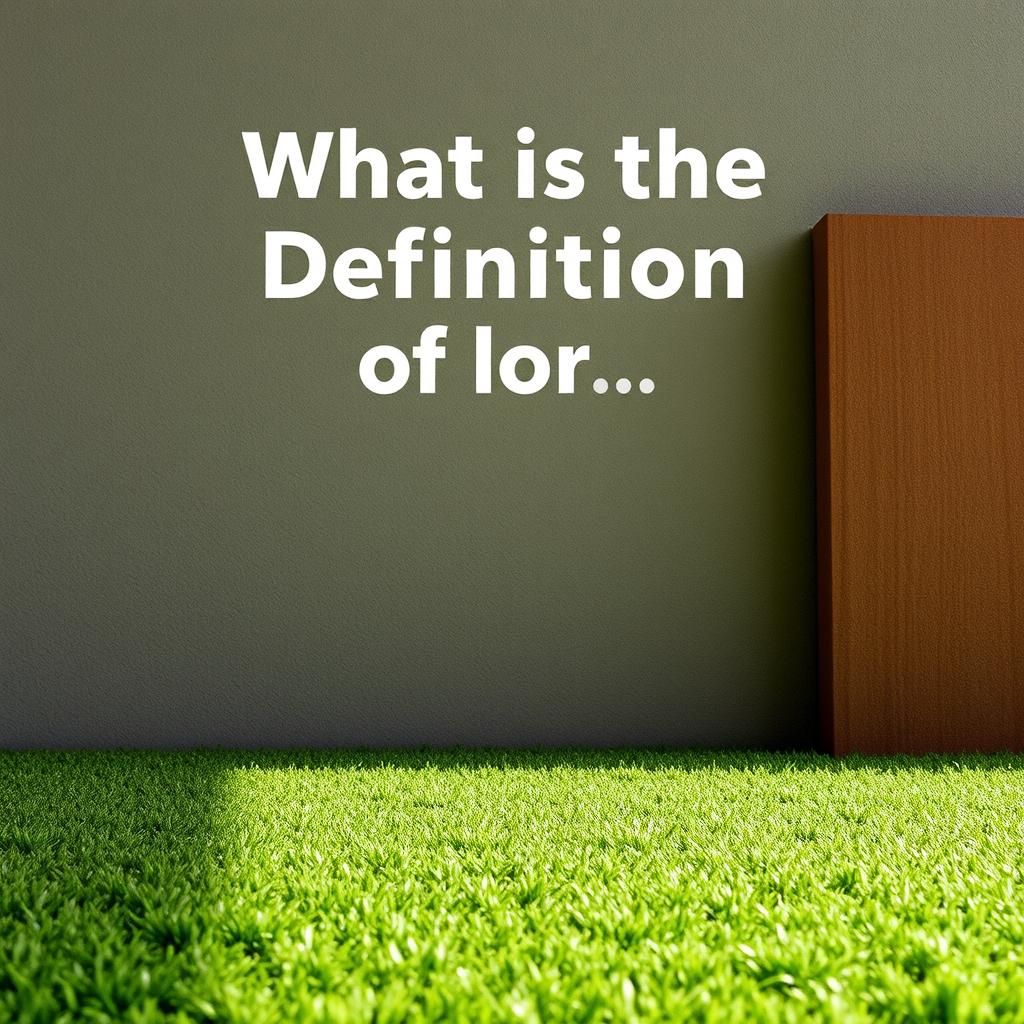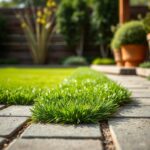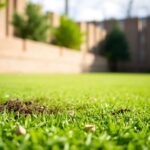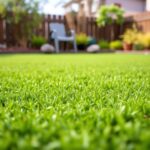What is the Definition of Turf? Understanding Its Meaning and Uses

Turf, often associated with the green surfaces of sports fields and gardens, holds a multifaceted definition that extends beyond mere grass. This article delves into the meaning of turf, exploring its various forms and applications in landscaping, sports, and environmental management. From natural sod to synthetic alternatives, understanding turf involves recognizing its role in enhancing aesthetics, functionality, and sustainability. Whether you're a homeowner looking to beautify your lawn or a sports enthusiast aiming to comprehend the playing fields, grasping the complexities of turf can significantly impact how we appreciate and utilize this essential component of our outdoor spaces.
What is Turf?
Turf refers to the upper layer of soil that is covered with grass and roots, forming a durable surface. It is commonly used for landscaping, sports fields, and recreational areas. The definition of turf encompasses both natural grass and synthetic alternatives, which seek to mimic the appearance and function of real grass. Turf provides a variety of benefits, including improving aesthetics, supporting environmental functions, and offering a soft, safe area for activities, making it an essential component in many outdoor settings.
Types of Turf
There are several types of turf, primarily categorized into natural grass and synthetic turf. Natural grass is composed of various species of grass and is known for its aesthetic appeal and environmental benefits, such as cooling the surrounding area and improving air quality. Synthetic turf, on the other hand, is made from man-made materials designed to resemble natural grass, providing a low-maintenance alternative that can withstand heavy use. Each type has its pros and cons, making the choice dependent on intended use, maintenance preferences, and budget.
Applications of Turf
The applications of turf are vast and varied, ranging from residential lawns to sports fields and golf courses. Turf is commonly found in gardens, parks, and playgrounds, providing an attractive and functional surface for recreational activities. In sports, turf is essential for maintaining a uniform playing field, providing athletes with a high-quality surface for performance. Turf’s versatility extends to commercial properties, where it serves as a landscaping element that enhances curb appeal and value.
Turf Maintenance
Maintaining turf is crucial for achieving its desired appearance and performance. Natural grass requires regular mowing, watering, and fertilization to thrive, while synthetic turf typically requires less upkeep, involving occasional cleaning and brushing. The proper maintenance of turf ensures a healthy, vibrant surface that can endure seasons of use. It's essential to understand the specific needs of the turf type one is working with to implement effective maintenance practices.
Environmental Impact of Turf
The environmental impact of turf varies between natural and synthetic options. Natural grass contributes to biodiversity, carbon sequestration, and habitat for wildlife. It can effectively absorb rainwater, reducing runoff and improving soil health. Synthetic turf, while offering durability and low maintenance, may raise concerns about heat retention, water drainage, and potential chemical runoff. Balancing the environmental benefits and drawbacks is crucial when choosing the type of turf for specific applications.
The Future of Turf
The future of turf is advancing with innovations in both synthetic and natural options. Researchers are developing eco-friendly synthetic materials that are more sustainable and less harmful to the environment. Additionally, natural turf varieties are being engineered to require less water and resist drought conditions, catering to changing climates. As technology continues to evolve, the options for turf will broaden, providing homeowners, landscapers, and sports organizations with more sustainable and functional choices.
| Aspect | Natural Grass | Synthetic Turf |
|---|---|---|
| Maintenance | Requires regular care (mowing, watering) | Lower maintenance, minimal cleaning |
| Environmental Benefits | Absorbs carbon, improves air quality | Less environmentally friendly, heat retention |
| Durability | Varies based on use and weather | Highly durable, withstands heavy traffic |
| Aesthetic Appeal | Natural look, seasonal changes | Uniform appearance, year-round color |
| Cost | May require ongoing costs for upkeep | Higher initial costs, lower long-term maintenance |
What is the simple definition of turf?

The simple definition of turf refers to the upper layer of soil that has been covered with grass and its roots. Turf is commonly used in lawns, sports fields, and landscapes, providing a surface that is both aesthetic and functional. It can be natural or artificial, with natural turf composed of living grass and soil, while artificial turf is made from synthetic materials designed to mimic the appearance and feel of real grass.
What Comprises Turf?
Turf is essentially made up of several components that work together to create a healthy and resilient surface.
See also:
- Grass: The primary element, providing the green cover.
- Soil: The nutrient-rich layer that supports grass growth.
- Roots: These anchor the grass to the soil, facilitating nutrient uptake and water retention.
Types of Turf
There are various types of turf, each suited for different environments and purposes.
- Natural Turf: Real grass grown on soil, requiring maintenance through watering, mowing, and fertilization.
- Artificial Turf: Made from synthetic fibers, it resembles natural grass but requires less maintenance.
- Hybrid Turf: A combination of natural grass and synthetic fibers, offering durability alongside natural aesthetics.
Uses of Turf
Turf serves various purposes across different sectors, making it a versatile choice for many applications.
- Sports Fields: Used in football, soccer, and golf to create safe and durable playing surfaces.
- Residential Lawns: Provides an attractive and functional area for outdoor activities and landscaping.
- Parks and Recreation: Enhances public spaces for community enjoyment and environmental aesthetics.
Maintenance of Turf
Maintaining turf is essential for its health and longevity.
- Mowing: Regular cutting helps maintain an even height and promotes growth.
- Watering: Essential for root development, especially in dry conditions.
- Fertilization: Provides essential nutrients to support lush, green growth.
Benefits of Turf
Turf offers a multitude of benefits, making it a popular choice for both residential and commercial use.
- Environmental Impact: Turfs can help reduce soil erosion and improve air quality.
- Aesthetic Appeal: Provides a beautiful green landscape, enhancing the visual environment.
- Functional Surface: Creates safe areas for sports and recreation, reducing injury risks on surfaces.
What is the legal definition of turf?

The legal definition of turf typically refers to a type of land that is covered with grass and often maintained for recreational purposes or agricultural uses. In legal contexts, turf may be distinguished from other types of land based on its usage, ownership, and the rights associated with it. Turf areas can be included in discussions involving property law, land use regulations, and environmental laws.
Legal Aspects of Turf Ownership
The ownership of turf is generally associated with the rights to use and maintain specific land areas. Legally, turf can be maintained for various purposes such as sports, landscaping, or agricultural production. The rights of ownership may include:
- Exclusive Usage: Owners have the right to control access to the turf area.
- Maintenance Rights: Landowners are often responsible for the upkeep of the turf, which may include mowing, watering, and fertilizing.
- Development Rights: The owner may have the ability to modify the turf for different purposes, such as building structures or creating new recreational areas.
Turf areas are often subject to environmental regulations that aim to preserve the ecological balance. These regulations may impact how turf is maintained and what chemicals can be used. Key factors include:
- Pesticide Restrictions: Certain chemicals may be banned or regulated in turf maintenance to protect local wildlife.
- Water Usage: There may be laws governing the amount of water that can be used for irrigation on turf, especially in drought-prone areas.
- Wildlife Protection: Some turf areas may fall under protections that limit human activity to safeguard native habitats.
Real Estate Transactions Involving Turf
In real estate, turf can play a vital role in property assessments and transactions. Factors to consider include:
- Land Appraisal: The condition and quality of the turf can significantly affect property value.
- Disclosure Requirements: Sellers may need to disclose any issues related to turf maintenance or contamination.
- Lease Agreements: Rental agreements may specify responsibilities for turf care and maintenance practices.
Sports and Recreation on Turf
Turf is essential for various recreational activities and sports, influencing legal considerations for venues. Important aspects include:
See also:
- Liability Issues: Owners must manage risks associated with turf use, including injuries that may occur.
- Insurance Requirements: Facilities may need specific coverage related to turf-related activities.
- Compliance with Standards: Many sports organizations have regulations that turf areas must meet, affecting maintenance and design.
Turf Disputes in Legal Contexts
Disputes involving turf can arise from disagreements over land use, maintenance, and rights. Common issues include:
- Boundary Disputes: Conflicts may occur over the exact boundaries of turf areas, affecting ownership rights.
- Use Rights Disputes: Neighbors may disagree over how turf should be used, such as for recreational vs. commercial purposes.
- Maintenance Obligations: Disputes can arise regarding who is responsible for maintaining the turf area, especially in shared spaces.
What does it mean to be in one's turf?

To be in one's turf means to be in a place or environment where one feels comfortable, confident, and has a sense of ownership or control. This phrase often implies that the individual is in a familiar setting where they know the rules, the dynamics, and the people involved. It's often used in contexts like sports, business, or social interactions to indicate that someone has an advantage due to their familiarity with the area or situation.
Understanding the Origin of the Phrase
The expression in one's turf originates from the word turf, which refers to the area of ground covered by grass or a specific piece of land. In its extended use, it signifies a territory that is associated with a person or group. Over time, this has evolved into a metaphorical use, emphasizing the idea of having a strong relationship with a specific environment or community.
- Turf as a Symbol of Ownership: The term highlights a sense of personal stake or belonging.
- Territorial Behavior: It reflects how people may protect their turf against outsiders.
- Power Dynamics: Understanding who controls the turf allows for insights into local hierarchies.
The Importance of Familiarity
Being in one's turf showcases the benefits of familiarity. When an individual knows their surroundings well, they can navigate challenges more effectively and leverage their knowledge to their advantage. Familiarity fosters confidence and can lead to better decision-making in various situations.
- Confidence Boost: Understanding the area leads to increased self-assuredness.
- Strategic Advantage: Knowledge of local norms can aid in strategic planning.
- Relationship Building: Familiarity with people facilitates stronger interpersonal connections.
When someone is in their turf, they often have enhanced abilities to engage in social interactions. Such environments allow individuals to network more effectively, as they are more likely to encounter familiar faces or know whom to approach for information or support.
- Building Trust: Being in a familiar setting cultivates trust among peers.
- Strategic Networking: Leveraging known relationships can open doors to opportunities.
- Effective Communication: Familiarity often leads to clearer and more effective dialogue.
Implications in Competitive Contexts
In competitive settings, being in one's turf can often translate to a better chance of success. Individuals or teams that operate within their own turf tend to have a deeper understanding of their competition and the local landscape, which can significantly influence the outcome of competitive events.
- Home Advantage: Familiarity with the environment can boost performance.
- Knowledge of Competitors: Understanding the competition’s strengths and weaknesses enhances tactical planning.
- Resource Allocation: Being informed helps in making better resource decisions.
Challenges of Being Outside One's Turf
While being in one's turf has many advantages, stepping outside of it can bring challenges. Individuals may feel vulnerable or uncertain when placed in unfamiliar environments, which could hinder their performance or ability to interact.
- Increased Anxiety: New settings can lead to stress and discomfort.
- Social Barriers: Meeting new people can be challenging without pre-existing relationships.
- Unfamiliar Norms: Not knowing the local rules can result in misinterpretations or errors.
Questions from Our Readers
What is the definition of turf?
Turf generally refers to the layer of soil that includes grassroots and the upper part of the soil, typically found in grassy areas. It can also describe the area itself covered by grass or a specific type of lawn. Turf is commonly used for recreational areas, such as sports fields and golf courses, where a durable and well-maintained grass surface is essential.
What materials are commonly used to create turf?
There are two main types of turf: natural turf, which consists of real grass grown on soil, and artificial turf, made from synthetic fibers designed to mimic the appearance of natural grass. Natural turf requires soil, seeds, and water, while artificial turf is composed of various materials such as polyethylene, polypropylene, and nylon.
See also:
What are the advantages of using turf?
One of the primary advantages of turf is that it provides a durable and aesthetically pleasing surface for sports and recreational activities. In the case of natural turf, it is environmentally friendly, helps with soil erosion control, and can improve air quality. On the other hand, artificial turf requires minimal maintenance and can be used in varied climates without the need for regular watering.
How is turf maintained?
Maintaining turf involves several key practices, including regular mowing, watering, aerating, and fertilizing natural grass to keep it healthy and lush. For artificial turf, maintenance typically includes brushing to keep the fibers upright, rinsing to remove dirt or debris, and checking for any damage to ensure its longevity and performance.

If you want to read more articles like What is the Definition of Turf? Understanding Its Meaning and Uses, we recommend you check out our Turf category.
Leave a Reply
Related Articles